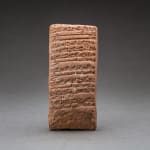Cuneiform Tablet, 2036 BCE
Clay
10.2 x 4.7 cm
4 x 1 7/8 in
4 x 1 7/8 in
LSO.24
Clay Tablet, with 35 lines of Sumerian Cuneiform writin This is an administrative tablet from the period of the Third Dynasty of Ur, dated to the 21st day of the...
Clay Tablet, with 35 lines of Sumerian Cuneiform writin This is an administrative tablet from the period of the Third Dynasty of Ur, dated to the 21st day of the first month of the second year of Shi-Sin, fourth king, c. 2036 BC. The day of the month is entered down the elft edge. The tablet is in fair condition with some surface abrasion, especially at the top of the reverse, but most of the text is legible. The ancient scribe erased the first three lines on the obverse. Thus our translation begins with line 4: Translatio 2 sila of bun, 2 fish: Mr Mashum, groom, king’s messenge 2 sila of bun, 2 fish: Mr Mazati, herald, king’s messenger when he went from Der to the kin 2 sila of bun, 2 fish: Mr Lugal-isib-ea, king’s messenge 2 sila of bun, 2 fish: Mr Su-Bubu, king’s messenger when he went to muster the serf groom 1 sila of bun, 1 fish: Mr Iddin-Erra, king’s messenge (three lines too damaged to read)
1 sila of bun, 1 fish: Mr Ili-Kima…, king’s messenge when he went to De 1 sila of bun, 1 fish: Mr Sharrum-bani, king’s messenge 2 sila of bun, one fish: Mr Adad-bani, king’s messenge when he went to muster the serfs for the barley harvest.A disbursement, month barley harvest, year: Enki’s boat “the Ibex of the Apsu” was caulke ***** A sila was about .85 of a litre. The word we have translated (as) bun is of uncertain meaning, but occurs close to “bread” in other texts. This tablet is a ‘new’ kind of messenger tablet. Such tablets have long been known, but never before was every man specified as "kings messenger", and never before was the specific mission given with some of the men. Also the issue of "bun" and fish seems to be new here. The fish could of course be dried, not fresh. Der was a town in the Diyala Valley, on the route from Sumer to West Iran.
1 sila of bun, 1 fish: Mr Ili-Kima…, king’s messenge when he went to De 1 sila of bun, 1 fish: Mr Sharrum-bani, king’s messenge 2 sila of bun, one fish: Mr Adad-bani, king’s messenge when he went to muster the serfs for the barley harvest.A disbursement, month barley harvest, year: Enki’s boat “the Ibex of the Apsu” was caulke ***** A sila was about .85 of a litre. The word we have translated (as) bun is of uncertain meaning, but occurs close to “bread” in other texts. This tablet is a ‘new’ kind of messenger tablet. Such tablets have long been known, but never before was every man specified as "kings messenger", and never before was the specific mission given with some of the men. Also the issue of "bun" and fish seems to be new here. The fish could of course be dried, not fresh. Der was a town in the Diyala Valley, on the route from Sumer to West Iran.



